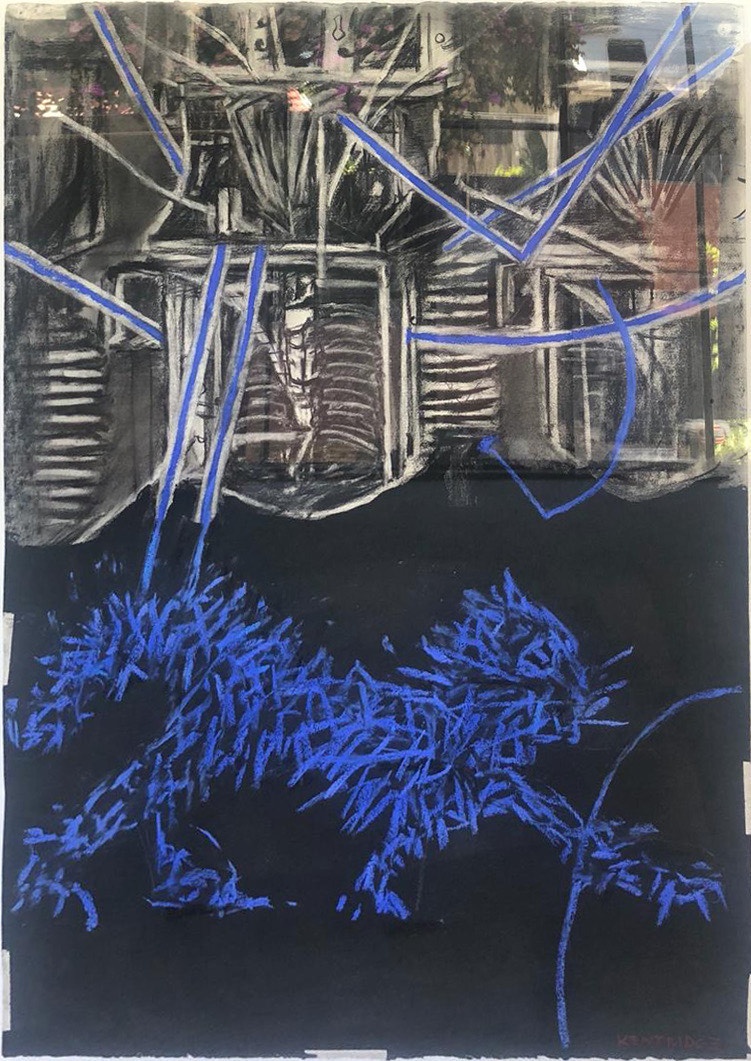William Kentridge

The sinuous black cat is a recurring character in Kentridge’s work, stalking his charcoal compositions and animations alike. In this drawing from Stereoscope, the eighth film in Kentridge’s decades-long series Ten Drawings for Projection, the cat plays an associative and ambiguous role as shapeshifter becoming typewriter, Bakelite phone and later, bomb. “I never start with a meaning, so cannot tell you what the cat symbolises,” the artist says of its import. “If anything – I simply knew that I needed a cat at that moment of the film.” The cat’s image shifts, cleaves, is twinned by the double sight the film’s title suggests. Taking stereoscopic vision as formal device, Kentridge’s film offers an allegory of perception in seeing and sign. The narrative’s blue motif, which draws connecting lines between characters, later electrifies the cat, casting it a cobalt hue, reducing it to a cluster of static lines as seen in Drawing from Stereoscope (Blue cat).
b.1955, Johannesburg
Performing the character of the artist working on the stage (in the world) of the studio, William Kentridge centres art-making as primary action, preoccupation, and plot. Appearing across mediums as his own best actor, he draws an autobiography in walks across pages of notebooks, megaphones shouting poetry as propaganda, making a song and dance in his studio as chief conjuror in a creative play. Looking at his work, a ceaseless output and extraordinary contribution to the South African cultural landscape, one finds a repetition of people, places and histories: the city of Johannesburg, a white stinkwood tree in the garden of his childhood home (one of two planted when he was nine years old), his father (Sir Sydney Kentridge) and mother (Felicia Kentridge), both of whom contributed greatly to the dissolution of apartheid as lawyers and activists. The Kentridge home, where the artist still lives today, was populated in his childhood by his parents’ artist friends and political collaborators, a milieu that proved formative in his ongoing engagement with world histories of expansionism and oppression throughout the 20th century. Parallel to – or rather, entangled with – these reflections is an enquiry into art historical movements, particularly those that press language to unexpected ends, such as Dada, Constructivism and Surrealism.
Moving dextrously from the particular and personal to the global political terrain, Kentridge returns to metabolise these findings in the working home of the artist’s studio, where the practitioner is staged as a public figure making visible his modes of investigation. Celebrated as a leading artist of the 21st century, Kentridge is the artistic director of operas and orchestras, from Sydney to London to Paris to New York to Cape Town, known for his collaborative way of working that prioritises thinking together with fellow practitioners skilled in their disciplines (for example, as composers, as dancers). Most often, he is someone who draws, in charcoal, in pencil and pencil crayon, in ink, the gestures and mark-making assured. In a collection of books for which A4 acted as custodian during the exhibition History on One Leg, one finds 200 publications devoted to Kentridge’s practice. In the end, he has said, the work that emerges is who you are.